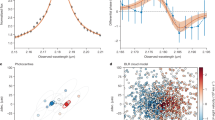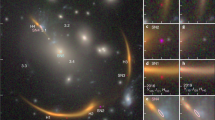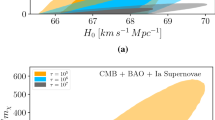Abstract
IN the double quasar 0957 + 0561, the first detected example of a gravitational lens1, a quasar at redshift z = 1.41 appears as two images separated by ˜6 arcsec and accompanied by an extended radio source2–4. The Hubbie constant, H0, can be estimated from the angular separation and the time delay between the appearance of the same brightness variations in the two images—a method that avoids all the usual uncertainties that attend the estimation of distance by the use of standard candles. From 11 years of Very Large Array (VLA) observations we have found the time delay to be 1.40 ± 0.10 yr, a significantly larger and more robust value than has been obtained from optical measurements5,6. Using a standard lens model7 and taking the observed velocity dispersion of luminous matter in the lensing galaxy8 to measure the true gravitational potential, we find HQ = 46 ± 14 (42 ± 14) km s-1 Mpc-1 for cosmic density parameter ω0 = 0 (1), in approximate agreement with Rhee's recent estimate8. But if, as is likely, there is dark matter in the lensing galaxy, H0 could be as high as 69 ± 21 (63 ± 21) km s-1 Mpc-1. The agreement of several completely independent estimates of H0 gives some confidence that the scale of the Universe is indeed known to about a factor of two.
This is a preview of subscription content, access via your institution
Access options
Subscribe to this journal
Receive 51 print issues and online access
$199.00 per year
only $3.90 per issue
Buy this article
- Purchase on SpringerLink
- Instant access to full article PDF
Prices may be subject to local taxes which are calculated during checkout
Similar content being viewed by others
References
Walsh, D., Carswell, R. F. & Weymann, R. J. Nature 279, 381–384 (1979).
Young, P. J. et al. Astrophys. J. 241, 507–520 (1980).
Young, P. J. et al. Astrophys. J. 244, 736–755 (1981).
Roberts, D. H. et al. Astrophys. J. 293, 356–369 (1985).
Vanderriest, C. et al. Astr. Astrophys. 215, 1–13 (1989).
Schild, R. E. Astrophys. J. 100, 1771–1776 (1990).
Falco, E. E., Gorenstein, M. V. & Shapiro, I. I. Astrophys. J. 372, 364–379; Center for Astrophysics Preprint No. 3103 (1991).
Rhee, G. Nature 350, 211–212 (1991).
Refsdal, S. Mon. Not. R. astr. Soc. 132, 101–111 (1966).
Dyer, C. C. & Roeder, R. C. Astrophys. J. 241, L133–L136 (1980).
Borgeest, U. & Refsdal, S. Astr. Astrophys. 141, 318–322 (1984).
Alcock, C. & Anderson, N. Astrophys. J. 302, 43–51 (1986).
Fukugita, M., Futamase, T. & Kasai, M. Mon. Not. R. astr. Soc. 246, 24P–27P (1990).
Lehár, J., Hewitt, J. N. & Roberts, D. H. Gravitational Lenses (eds Moran, J. M., Hewitt, J. N. & Lo, K. Y.) 84–89 (Reidel, Dordrecht, 1989).
Edelson, R. A. & Krolik, J. H. Astrophys. J. 333, 646–659 (1988).
Rickett, B. J. Ann. Rev. Astr. Astrophys. 28, 561–605 (1990).
Gorenstein, M. V. et al. Astrophys. J. 334, 42–58 (1988).
Young, P. J. Astrophys. J. 244, 756–767 (1981).
Schild, R. E. & Smith, R. C. Astr. J. 101, 813–817 (1991).
Bonometti, R. J. thesis, Massachusetts Institute of Technology (1985).
Faber, S. M. & Jackson, R. E. Astrophys. J. 204, 668–683 (1976).
Kent, S. M. Evolution of the Universe of Galaxies (ed. Kron, R. G.) 109–118 (Astronomical Society of the Pacific, San Francisco, 1990).
Gott, J. R. III Ann. Rev. Astr. Astrophys. 15, 235–266 (1977).
van den Bergh, S. The Extragalactic Distance Scale (eds van den Bergh, S. & Pritchet, C. J.) 375–377 (Astronomical Society of the Pacific, San Francisco, 1988).
Bartel, N. IAU Symp. No. 129, The Impact of VLBI on Astrophysics and Geophysics (eds Reid, M. J. & Moran, J. M.) 175–184 (Reidel, Dordrecht, 1988).
Kochanek, C. S. Astrophys. J. (in the press).
Author information
Authors and Affiliations
Rights and permissions
About this article
Cite this article
Roberts, D., Lehár, J., Hewrtt, J. et al. The Hubble constant from VLA measurement of the time delay in the double quasar 0957+561. Nature 352, 43–45 (1991). https://doi.org/10.1038/352043a0
Received:
Accepted:
Issue date:
DOI: https://doi.org/10.1038/352043a0
This article is cited by
-
The case for the relativistic hot Big Bang cosmology
Nature (1991)
-
More Hubble trouble?
Nature (1991)



